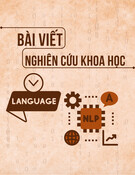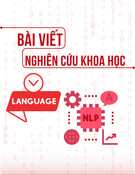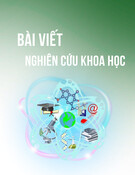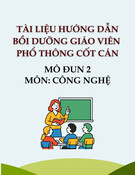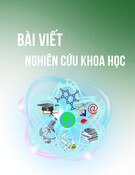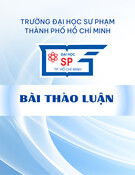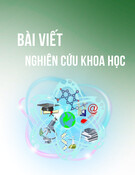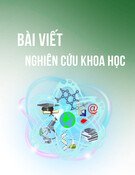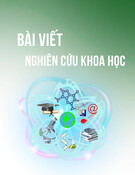
90
Siddhajyoti Interdisciplinary Journal, Volume 2, January, 2021
Difficulties of Grade X students in learning Trigonometry
Tara Nath Adhikari
Abatar Subedi
Abstract
This paper aims to explain the difficulties of grade X students in learning trigonometry that
were explored from an empirical study in the year 2017 AD. The researcher used explanatory
mixed research design where 155 students of grade X were selected randomly from the four
schools of Kirtipur municipality to conduct initial survey to find low achievers and most
difficult content areas of trigonometry by using achievement test. Then five low achievers
and respective three mathematics teachers were selected and interviewed with the help of
semi-structured interview guidelines to explore what difficulties had they experienced and
encountered in learning trigonometry. The results revealed that mean achievement score of
students in institutional schools was greater than that of students of community schools.
However, there are some common areas of difficulties of students in both types of schools
for learning trigonometry including the difficulties related to memorization of facts;
comprehension of new concepts; transformation of verbal problems; derivation and proofs
of trigonometric relations and unfamiliarity with the solving process of problems in
application level. These difficulties are due to several reasons including abstract nature of
contents, poor prerequisites among students, demonstration of teacher centered instruction,
and focusing on rote memorization rather than conceptual understanding. Hence, it is
recommended that both students and teachers need to focus on conceptual learning rather
than rote memorization for meaningful understanding in trigonometry.
Keywords:Learning trigonometry, remembering facts, comprehension of concepts,
deriving results, applying the formulae
Introduction
School mathematics is becoming a fundamental course for the people living in this
contemporary world. Teaching such fundamental course and finding difficulties to learn it, is
an ongoing phenomenon for the educational research. The curriculum of school mathematics
of Nepal, particularly at grade X, consists of several mathematical concepts including
Arithmetic, Geometry, Algebra, Trigonometry, and Statistics. Among these core areas of
contents, trigonometry covers 20 percentages of all contents. Trigonometry is a branch of
mathematics which deals the relationships between lengths, angles, triangles and so forth.
Basically, the contents in the trigonometry are based on the concepts of right angle triangle.
So, learning trigonometry means to understand symbols, language, relationships, identities,
equations and other verbal problems. Also, trigonometry is effective and useful for measuring
the height and distance, length of shadow and height of any object from the horizontal line
(Ginsburg, 2016). This implies that if school students cannot understand the language,
relationships and other useful property of trigonometry ultimately a rises difficulties to learn
it.
The evident of the courses of school mathematics of Nepal shows that trigonometry
is one of the major content areas of mathematics at secondary level. The study of trigonometry
courses is just starting from grade IX and so on for the community school of Nepal. The
contents of trigonometry are taught in compulsory mathematics course to some extent and in
detail in the optional courses of mathematics at grade IX of Nepal. Teaching such new contents

91
Siddhajyoti Interdisciplinary Journal, Volume 2, January, 2021
at grade IX is a challenging task for the mathematics teachers. The teachers’ preparations,
knowledge, ideas and methods to teach trigonometry are important variables to make learning
meaningful, effective and to reduce students’ difficulties to learn it. Teacher’s readiness and
interest in teaching are also important for teaching learning activities as well as developing
the positive attitude in the students towards mathematics learning (Kamber&Takaci, 2018).
That means teacher need to enter the classroom with full preparation of the contents and
methods to teach mathematics effectively which will develop positive attitude among students
in learning mathematics. Teachers need to have capacity to show the application of the
mathematics contents, particularly the application of trigonometry. For example, it is used in
oceanography for calculating the heights of oceans. The sine and cosine functions are
fundamental to the theory of periodic functions which describe the sound and light waves.
It has also its applications in satellite systems.
On the other hand, it is expected that learning trigonometry develops the critical
thinking power of students in mathematics. Acharya (2015) and Courtney (2016) stated that
the study of contents in trigonometry helps students to develop the capacity of visualizing
any mathematical contents differently. That means the strong knowledge of trigonometry has
wider applications in learning any contents of mathematics from school to higher level. In
this context how school students learn these widely useful contents (trigonometry) and what
difficulties are arising for them to learn it effectively was the concern of this study. Equally,
how the teachers have experienced students’ difficulties in learning trigonometry was also
considered to find the students difficulties in learning it.
Research Objectives
The objectives of this study were to find out most difficult content areas of
trigonometry and to explore some difficulties of grade X students in learning trigonometry in
the course of elective (optional) mathematics.
Literature Review
There are several literatures which explain the student’s difficulties in learning school
mathematics, particularly difficulties in learning trigonometry. The study of Ghimire (2013)
pointed that cultural background and participation plays the vital role in their mathematics
learning. This study also revealed that low participation of Bote students has made them
difficult to learn mathematics. Similarly, Bhat (2017) explained that difficulties in learning
trigonometry are due to lack of group discussion, improper use of exercise books and lack of
using electronic instructional materials in mathematics. Also, the lack of selecting appropriate
teaching methods, fewer practices of related examples and lack of practices of project works
in school geometry are the major obstacles for meaningful learning (Yadav, 2017). That
means the choice of methods of teaching, assigning project works and learning materials
applied in the classroom are also creating difficulties in learning mathematics.
The research of Bhatta (2017) revealed that students have faced difficulties in learning
mathematics because the text books are not well planned and contents are not arranged
sequentially. There is also scarcity of reference books, teachers guide and math lab in rural
areas, and the curriculum is more urban oriented which affects the mathematics learning of
rural students. The culture of teacher and students also plays an important role in learning
mathematics. Gautam (2017) stated that there is not proper interaction between teacher and
Tamang students because of their language and culture. Thus the lack of local teachers in
Difficulties of Grade X............ Tara Nath Adhikari
Abatar Subedi

92
Siddhajyoti Interdisciplinary Journal, Volume 2, January, 2021
Tamang community and poor interpersonal relation developed among Tamang students are
creating difficulties in learning school mathematics, particularly in learning trigonometry.
Moreover, mathematics anxiety, negative feeling of mathematics, economic condition, their
educational background, school management system, infrastructure of school are the main
causes of difficulties in learning mathematics (Acharya, 2017).
On the other hand, symbols and symbolic structure had strong influence on students’
choices in problem solving (Kenney, 2008). That means if students cannot understand the
language, symbols and its structures then it is difficult to learn mathematics. For example,
graphing calculators used at a way to abandon symbolic manipulation, although few
connections were made between symbolic and graphic numerical form. Likewise, Ginsburg
(1994) pointed that the development of children’s construction of knowledge in the context of
schooling are the product of classroom instruction, the availability in children of informal
knowledge, the role of motivation, and the effects of specific interventions.
Mulwa (2015) had reviewed the literatures pertinent to difficulties encountered by
students in learning and usage of mathematical terminology and concluded that students
have difficulties in using mathematical terms and their related concepts when learning
mathematics. Similarly, the students have faced difficulties in learning higher mathematical
concepts like group theory are due to misconception, incapability of making linkage with
new concepts, unable to remember mathematical terminology for long time, and lack of
suitable learning resources (Bhandari, 2017). The students are becoming lazy and passive in
learning mathematics in classroom because of using only lecture methods and not giving
individual attention for students by teachers (Thapa, 2016), stimulating difficulties in learning
mathematics at school.
The literatures reviewed above display that there are several factors which influence
mathematics learning, particularly learning concepts in trigonometry including classroom
environment, economic condition, peer groups discussion, pre-knowledge of subject matter,
teaching methods and materials, language, culture, classroom participation and regularity.
Also, the lack of sufficient learning resources, motivation and regular evaluation of students’
progress are also responsible to create difficulties in learning mathematics at school. The
reviews also indicate that the selection of appropriate methods in teaching and learning
mathematics including the concepts of trigonometry at school level plays a vital role. The use
of student centered methods for teaching and learning mathematics like problem solving,
project methods, modern techniques (that is blended with ICT), discovery method, collaborative
methods, and so forth and the demonstration of concrete materials related to mathematics
concepts can make learning more meaningful and conceptual. That is why, this study intended
to find the major difficulties in the content areas of trigonometry as experienced by grade X
students and respective mathematics teachers. These difficulties might be related to nature of
contents, teachers and students’ activities, classroom environments, students’ backgrounds
and others as reflected from the literature reviewed as above.
Research Methods
This study adopted the mixed research design, particularly the explanatory design
for which the researcher surveyed 155 students of grade X at first to find the low achievers in
trigonometry. These students were selected randomly from four schools (55 students from
two community schools and that of 100 from two institutional schools) where schools were
Difficulties of Grade X............ Tara Nath Adhikari
Abatar Subedi

93
Siddhajyoti Interdisciplinary Journal, Volume 2, January, 2021
selected from same location of Kirtipur Municipality in the year 2017 AD. The achievement
test was administrated to find out the most difficult contents or problems area of trigonometry
as experienced by selected students and from which five low achievers (three from institutional
and two from community schools) and three respective teachers who were teaching optional
mathematics at grade X were chosen to explore difficulties that were experiencing in the
learning process of trigonometry with the help of semi-structured interview guidelines. There
were 18 questions in the achievement test which were constructed from the content of
trigonometry and prepared on the basis of Bloom’s taxonomy. Split-half method was used to
compute the reliability of achievement test in which the reliability coefficient was found 0.85
that ensured the tool was reliable. The interview guidelines for both students and teachers
were prepared to explore difficulties in relation with the memorization of facts, comprehension
of contents, derivation of formulae, justification of theorems, application of contents and
transition of verbal problems. The validity of achievement test paper was ensured with the
help of mathematics experts and research supervisor, however, that of qualitative information
were maintained by using triangulation of respondents. The obtained quantitative data were
analyzed and interpreted by using mean and standard deviation and that of qualitative
information’s were analyzed and interpreted in logical manner by using the general inductive
approach (Thomas,2006).
Results and Discussions
The results were presented and discussed as follows under the separate headings
coined from objectives of the study.
Analysis of Survey Results
This subsection analyzed the achievement results of surveyed students which helped
to select low achievers and to find most difficult contents area of trigonometry as expressed
by grade X students. Trigonometry is one of the major contents in the course of school
mathematics in which students need to memorize facts, definitions, and apply these facts to
solve the related problems included in the courses. The level of understanding of the concepts
in trigonometry and difficulties in learning the contents can be judged by taking achievement
test. So, this study considered achievement is one of the major indicators to find the most
difficult contents or problem areas of trigonometry as experienced by grade X students and
to select low achiever students for the detail explanation of difficulties in learning and solving
the problems in trigonometry. The following table reveals the mean and standard deviation of
achievement test of selected 155 Grade X students in trigonometry where the full mark of the
test was 50.
The results in the table show that mean achievement score of students in community
schools is less than that of institutional schools by 5.65 in trigonometry. This implies that
students in community schools are poor in learning trigonometry at grade X in comparison to
Difficulties of Grade X............ Tara Nath Adhikari
Abatar Subedi
Types of
School
Number of
Students
Mean score of obtained
mark
Standard Deviation of obtained
mark
Community 55 17.55 12.83
Institutional 100 23.2 10.62
Total 155 21.19 11.76

94
Siddhajyoti Interdisciplinary Journal, Volume 2, January, 2021
institutional schools. Likewise, the higher standard deviation in the achievement score of
students in community schools indicates the greater variability in achievements from average
marks than that of institutional schools. That means there is consistency in achievement
results of the students of institutional schools in comparison with community schools. However,
there was difficulties found among students in both types of schools in learning trigonometry
because they had got low average marks (that is 21.19) of all selected students out of 50 full
marks. Also, it was found that no one got the full mark in both type of school. It means that
there were difficulties for students in learning and completing achievement test in trigonometry.
The standard deviation is very high in both type of school in comparison to mean which
justify that there are students having very poor achievement level and greater difficulties in
learning trigonometry at grade X.
From the analysis of test papers of sample students, it was found that there were
several difficulties related to content areas of trigonometry which are analyzed and interpreted
in the following subsections. The test papers revealed that students have difficulties related
to remembering the trigonometric formula and definitions, meaningful comprehension of
contents, transition the verbal statements into figures, deriving formulae and proving theorems,
and application of concepts in trigonometry. These difficulties of content areas were
triangulated with the responses of selected five low performer students and respective teachers
of grade X to explain the details of those difficulties as they experienced in learning
trigonometry.
Remembering the Trigonometry Formulae and Definitions
Memorization of facts in trigonometry such as remembering formulae and definitions
are essential mental activities to learn it effectively. According to Bloom’s taxonomy, knowledge
level is the first level of cognitive domain that includes retrieving, recognizing, and recalling
information. The test paper of student showed that they did mistake in remembering formula
and they lost the mathematical terminology in definition. The following is one example of
student solution in achievement test for the question toexpressCos2X in terms of SinX and
TanX.
This result shows that student made mistakes to express Cos2X into Sin X and Tan
X. The correct answer is Cos2X = 1 – 2 Sin
2
X and Cos 2X = (1 – Tan
2
X) / (1 + Tan
2
X). That
means students didn’t care and remember the correct formula for that concept. They made
mistake in using proper sign for the concepts and forget to write coefficient 2 for Sin
2
X. One
Difficulties of Grade X............ Tara Nath Adhikari
Abatar Subedi

